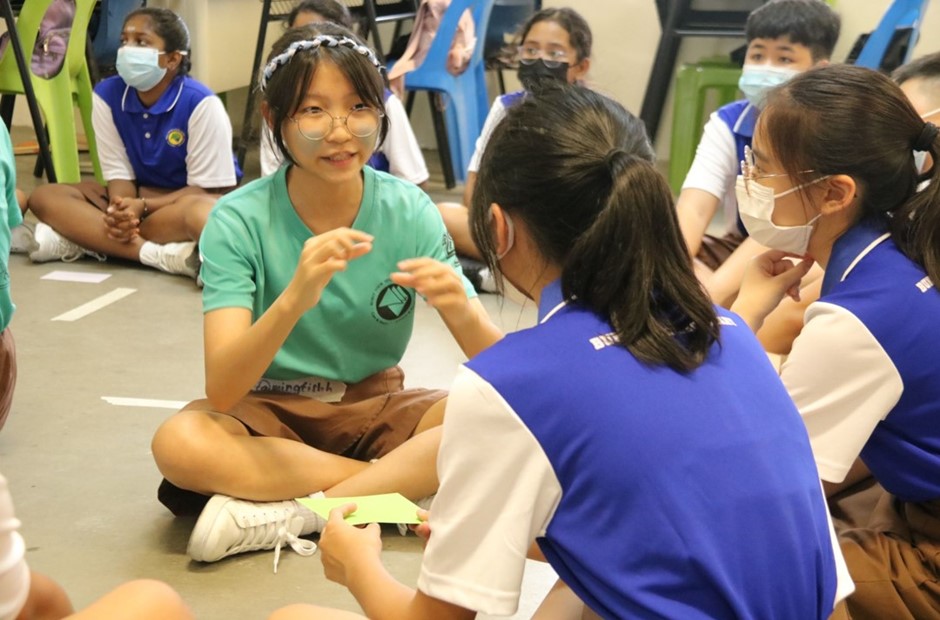Leadership can be a tricky quality to identify. Students applying for the DSA Leadership programme typically already have a track record of serving as a prefect or Co-Curricular Activity (CCA) leader in primary school, or some sort of similar experience.
Naval Base Secondary School goes a step further to ask applicants to elaborate on their experiences. This is to find out if they embody specific leadership dispositions such as being self-reflective and collaborative, having a heart to serve, and more. “We also want to see if they have clarity of thought as they communicate, and align with our RECIPE values – which stands for respect, resilience, care, integrity, passion, and excellence,” explains Mr Shawn Neo, the Subject Head for Student Leadership at this school.
On top of that, Naval Base also sets a group challenge to observe how the students behave when they have to work together on a task. This is to gain insights on how students navigate differences, approach problem-solving and contribute to group goals – qualities that Mr Neo says are essential for future leaders.
Bukit View Secondary School sets a group task and interviews students as a group as well. “We want to see how well they listen to one another and build on their peers’ answers,” says Mr Norafiq Ismail, one of the teachers in charge of this school’s Leadership Development. “An outstanding candidate will be someone who can really synthesise the thoughts in the room.”
At New Town Secondary School, teachers also keep in mind that leadership styles are diverse while conversing with applicants. “Not every leader is someone who is rah-rah and boisterous. We also appreciate students who may be quieter, but show maturity in thought,” says Ms Adora Tan, one of the teachers in charge of Student Leadership at the school. “Sincerity and a disposition of wanting to serve also form a good starting point.”
Here’s a closer look at how these three schools nurture students’ leadership skills.
At Bukit View Secondary School, student leaders are guided to chart their own course
Bukit View believes that all students have innate leadership potential. So, students who enter through the DSA Leadership route have access to the same opportunities as their schoolmates, and can join whatever CCAs they like. If they are interested in leadership positions, they have to step up to the plate. “It’s a light-touch approach,” says Mr Norafiq. “We want them to choose their path based on their passion and talent.”

That said, DSA Leadership students do tend to get specific opportunities, such as serving as student ambassadors during events like Open House. Teachers also keep an eye on their progress and give them a nudge if needed. “If these students are not taking on any leadership roles, I’ll seek them out to give them projects, and talk to them about how they can work on themselves and how else they can contribute,” says Ms Kumutha Maniam, another teacher who steers Bukit View’s Leadership Development.
At the start of students’ secondary school journey, teachers can play more of a guiding role in leader selection. By Secondary 2 though, student leaders, such as Peer Support Leaders and Student Councillors on the school’s Student Leaders Council, are typically nominated by their peers.
Generally, however, DSA Leadership students usually show a lot of initiative. For instance, Secondary 3 students Catherine Cing and Nami Nandana are both Student Councillors, and would like to run for spots on the executive committee next year. Catherine is also currently the vice-president of the school’s dance CCA, while Nami is one of the vice-captains for the track and field CCA. From organising events to instilling discipline, they are learning a lot from their seniors and hoping to work towards more senior leadership roles in their respective CCAs in upper secondary.
This year, the school is trying out a new rubric for evaluating leadership development, and it includes criteria such as the abilities to collaborate and to adapt to ambiguity. During reflection sessions for Student Councillors, for instance, teachers guide these student leaders to talk about which of these criteria are their strengths, and which are weaknesses.
“We’re trying to further define what a successful student leader looks like, and make it more tangible,” says Mr Norafiq. Moving forward, they hope to expand the use of this rubric to CCAs and other school activities. “It helps clarify where students currently stand in their leadership journey, and the areas they need to work on to become better leaders and peer influencers.”
At Naval Base Secondary School, student leaders are supported by a mentoring structure
All Naval Base students go through leadership training modules, which are based on the five practices of exemplary leadership proposed by researchers Jim Kouzes and Barry Posner – model the way, inspire a shared vision, challenge the process, enable others to act, and encourage the heart. These principles guide students to lead with empathy, integrity, and a focus on positive impact.
Students who enter through the DSA Leadership programme also become part of their class committee in Secondary 1 before joining the Student Council in Secondary 2. They also have to join a uniformed group CCA, because the school believes these CCAs will help them build character and instil discipline, as well as provide an environment conducive to building resilience and teamwork.
The Student Council has five boards focused on environmental issues, citizenship education, peer support, aesthetics, and sports and wellness respectively. In Secondary 2, new Student Councillors learn more about how some of these boards work, with help from a Secondary 3 mentor. When they reach upper secondary, councillors can pick the board they want to join to deepen their involvement and foster their field of interest.
DSA Leadership student Venugopal Pranav Charan, who is now in Secondary 4, is part of the council’s citizenship education board. He chose this board due to his longstanding fascination with Singapore history. He has been involved in initiatives such as organising Racial Harmony Day celebrations, and planning cultural activities for visiting students from China so they can learn more about Singapore’s multiculturalism.

Pranav had been part of the Student Council in his primary school as well, and used to think of leadership as the shouldering of various responsibilities. Three years into his time at Naval Base, this perception has shifted and he now sees it more as a collaborative process. “Here, the activities are more student-initiated,” he shares. “We plan them ourselves and propose our ideas to the teachers.”
That means he’s had many chances to strengthen his teamwork and communication skills to help teachers and students find common ground. “We have to figure out how to come to a consensus to achieve a win-win situation,” he elaborates.
Naval Base Secondary believes that this blend of initiative, empathy and problem-solving skills that it hopes to cultivate in its student leaders will equip them to serve both their student community, and eventually, the society.
At New Town Secondary School, there are multiple platforms and pathways for student leadership
Following a 2023 merger of Tanglin Secondary School with New Town Secondary School, this school now marries the best of both worlds when it comes to its leadership philosophy. New Town’s vision to nurture confident learners and caring leaders is guided by SPARK framework (which stands for Selection, Provision, Affirmation, Reflection, and Knowledgeable Others) to form the newly merged school’s leadership development initiatives.
SPARK is also based on Kouzes and Posner’s five leadership practices. “We believe every student can be and should be developed as a leader,” says Ms Tan of the “selection” part of this framework. Students may choose to and eventually be selected as leaders at the class committee and/or CCA levels, or for the Peer Support Leaders’ or Student Council Boards. Following their appointment, all students are provided with many platforms and opportunities to hone their leadership skills. They are also offered leadership training programmes.
To affirm student leaders, the school has created recognition mechanisms such as the Caring Leader Award. Students are guided through regular reflection sessions to gauge how much they have internalised the five practices.
The K in the SPARK framework which stands for knowledgeable others refers to external partners and stakeholders whom the student leaders can learn from and be inspired. Students have opportunities to attend leadership conferences organised by other schools, sharing sessions on leadership experiences by former student leaders and existing partnerships with the community and other organisations. For example, Secondary 2 students take part in the CAPT Student Leader Action Mentorship (CAPTSLAM), run by the College of Alice and Peter Tan at the National University of Singapore.
In Secondary 3, some students take on more prominent leadership roles in their classes, CCAs, or the respective boards for Peer Support Leaders and the Student Council. At this point, these students will get more specific training, such as courses in public speaking and project management, to help them in these new roles.
Some teachers do choose to appoint DSA Leadership students to certain leadership positions, such as class chairperson. But by and large, “there are no specific privileges, and we don’t lay out everything for you,” says Ms Rozaina Rusli, the Head of Department for Student Management and in-charge of Student Leadership. This ensures that leadership opportunities are made equally available to all students regardless if they had entered the school via the DSA Leadership route. For example, all students can throw their hat in the ring if they want to try for the role of Peer Support Leader or Student Councillor. They can also be peer-nominated, or teacher-nominated – all three paths are equally valid.
Secondary 3 and DSA Leadership student Nur Hidayah binte Zulkiffle was nominated by a teacher to become a Student Councillor. “I was nervous, but after learning from my seniors, I have become more confident about bonding with my peers, talking to the teachers, and sharing my own thoughts,” she says.

Secondary 2 and DSA Leadership student Jayden Cheng, who enrolled via the DSA Leadership route, is now a Peer Support Leader. It is a role he is familiar with because he’s held it in primary school. Back then, a teacher had noticed the way he helped a friend who was in distress and encouraged him to become a peer support leader. Now, he continues to build on his strengths. “I think I’m a good listener,” he says. “I’ve learned more about leading with empathy, and not judging my peers.”
Photos courtesy of: Bukit View Secondary School, Naval Base Secondary School, New Town Secondary School






